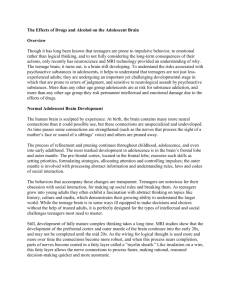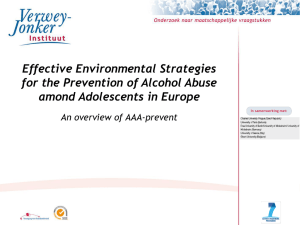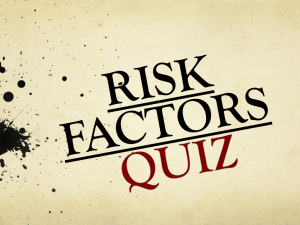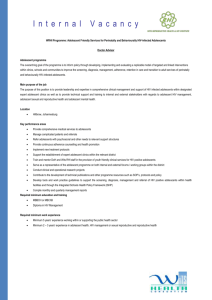Research Critique - PPE 310: Health Literacy e
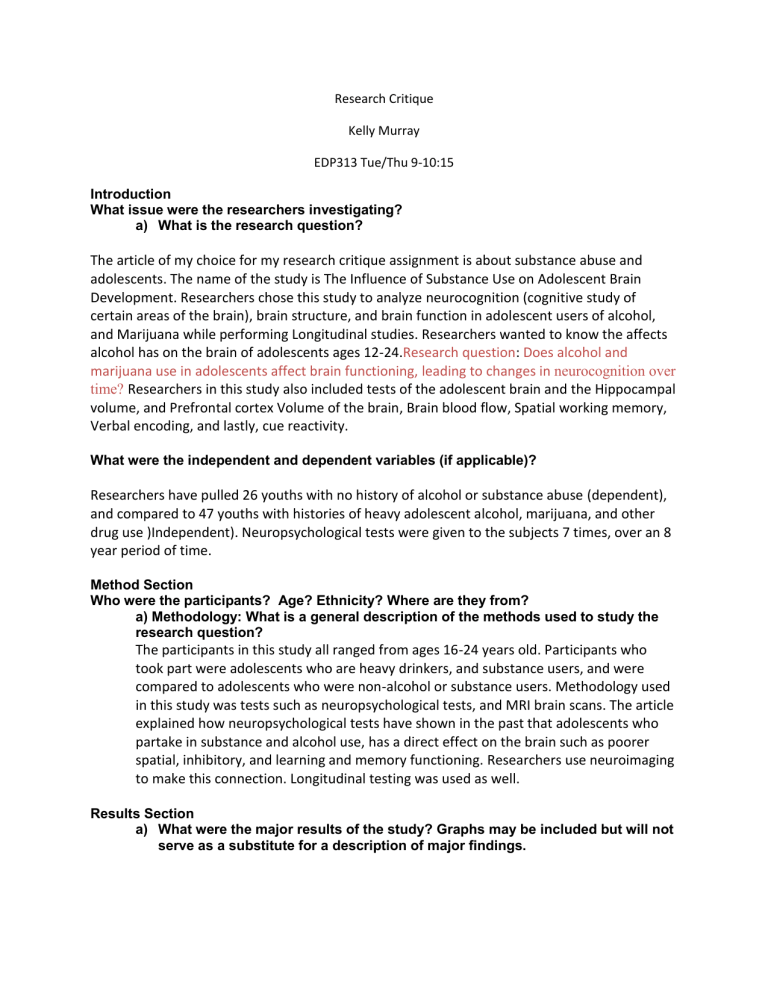
Research Critique
Kelly Murray
EDP313 Tue/Thu 9-10:15
Introduction
What issue were the researchers investigating? a) What is the research question?
The article of my choice for my research critique assignment is about substance abuse and adolescents. The name of the study is The Influence of Substance Use on Adolescent Brain
Development. Researchers chose this study to analyze neurocognition (cognitive study of certain areas of the brain), brain structure, and brain function in adolescent users of alcohol, and Marijuana while performing Longitudinal studies. Researchers wanted to know the affects alcohol has on the brain of adolescents ages 12-24.
Research question : Does alcohol and marijuana use in adolescents affect brain functioning, leading to changes in neurocognition over time? Researchers in this study also included tests of the adolescent brain and the Hippocampal volume, and Prefrontal cortex Volume of the brain, Brain blood flow, Spatial working memory,
Verbal encoding, and lastly, cue reactivity.
What were the independent and dependent variables (if applicable)?
Researchers have pulled 26 youths with no history of alcohol or substance abuse (dependent), and compared to 47 youths with histories of heavy adolescent alcohol, marijuana, and other drug use )Independent). Neuropsychological tests were given to the subjects 7 times, over an 8 year period of time.
Method Section
Who were the participants? Age? Ethnicity? Where are they from? a) Methodology: What is a general description of the methods used to study the research question?
The participants in this study all ranged from ages 16-24 years old. Participants who took part were adolescents who are heavy drinkers, and substance users, and were compared to adolescents who were non-alcohol or substance users. Methodology used in this study was tests such as neuropsychological tests, and MRI brain scans. The article explained how neuropsychological tests have shown in the past that adolescents who partake in substance and alcohol use, has a direct effect on the brain such as poorer spatial, inhibitory, and learning and memory functioning. Researchers use neuroimaging to make this connection. Longitudinal testing was used as well.
Results Section a) What were the major results of the study? Graphs may be included but will not serve as a substitute for a description of major findings.
Overall neurocognition of an adolescent who has consumed alcohol on a regular basis is relatively lower than adolescents who do not participate in drinking. Research also showed that
Marijuana use had no long term cognitive effects on the brain, but did show lower performance test with cognitive flexibility, visual scanning, error communication, learning, and the working memory. As research states neurocognition is affected by alcohol use in adolescent brains, though what about the brain structure? The following results show the Hippocampal volume, and Prefrontal cortex Volume of the brain, White Matter volume of the brain, Brain blood flow,
Spatial working memory, Verbal encoding, inhibition, cue reactivity, and predicting relapse.
The hippocampal is a part of the brain that is used for memory; this was analyzed with MRI screening. The study compared (1) light to nondrinkers who had little to no marijuana use, compared to (2) heavy drinking adolescents, compared to (3) heavy marijuana users who also partook in heavy drinking. Results supported the hypothesis and showed that (2) heavy drinkers were shown to have smaller left hippocampal volumes, meaning that alcohol use has a great influence on the adolescent brain. Group (3) was shown to have some effect on the brain while using marijuana and alcohol, but not as much as an affect than heavy alcohol users.
Prefrontal Cortex Volume is associated with planning, inhibition, emotion regulation, and integration of novel stimuli, go through considerable neuromaturation during adolescent years.
Tests were done comparing Prefrontal Cortex volumes of heavy drinkers, non-drinkers, and drinkers + marijuana users. Results reveal that Prefrontal Lobes were smaller once again, in heavy drinkers. Interesting enough, the control group (Non-drinkers), and marijuana users show very few differences in lobe volume. The study then explained that marijuana users larger global gray matter volumes than non-substance users. Findings also stated that adolescents using marijuana are at a risk for disrupting the grey matter pruning process.
White matter volume in adolescents was measured by a preliminary analysis. The analysis participants were between ages 16-19 and what was being tested were binge drinkers, and binge drinkers who also used marijuana. There were also participants who were non-drinkers or smokers who were used as the control group. Overall there were a total of 42 adolescents who were analyzed. Continue later…
Brain blood flow is very important to the brain and body. If the flow of blood to the brain is disrupted, or altered, it can cause major damage to the brain tissue, and also influences blood oxygen signals. Chronic alcoholics who have been analyzed have shown to have reduced blood flow to the brain. A study was taken on young women who were dependent on alcohol, and compared their brain blood flow to nonalcohol users. Results were found by using an MRI machine and indicated that the brain blood flow was more decreased in the young women who were drinkers, than the ones who did not drink. These cases have shown that drinking and abusing alcohol will lead to a decrease in brain blood flow in adolescents.
ADOLESCENT SUBSTANCE USE AND BRAIN FUNCTIONING
Alcohol use in adolescents is correlated to decrease in brain functioning. The following tells what parts of the brain are affected based on multiple studies.
Spatial working memory is what makes someone perform cognitive tasks and shows brain response.
Studies have shown that after 1-2 years of adolescent who perform heavy drinking; their spatial working memory did show abnormalities. A group was analyzed comparing heavy drinkers to non-drinkers, results did show that when performing similar to similar tasks, the heavy, and non-drinkers weren’t much different, though heavy drinkers did show higher activation in the parietal lobe, with decreased activation in the occipital and cerebellar regions (CITE). The results conclude that after 1-2 years of heavy drinking, adolescent will see abnormalities with neurocognitive functioning. Other studies have been performed by analyzing adolescent who have engaged in drinking alcohol for more than 4-5 years have been tested with a MRI, and have shown to perform poorer on the same tasks the previous candidates have taken, and also the drinkers who have been engaged for a longer period of time show a decline in activation with parietal and frontal regions of the brain. Another quite fascinating study was done on marijuana use between the ages of 16-18. Candidates performed the same tasks and tests the previous studies have done, and results were very different. Marijuana users did show an increase in brain functioning in particular the parietal, frontal, and temporal regions. Marijuana users however did show to have less activation in the cerebellum, and occipital cortices than the control group.
Verbal encoding research and the affect alcohol has on speaking is comparing non-drinkers, to binge drinkers. The researchers were looking for the difference in verbal learning and processing. Results have shown that binge drinkers show less utilization of the memory while completing an encoding task than non-drinkers. Binge drinkers show to have encoded fewer words than non-drinkers while performing the encoding test. Lastly, binge drinkers show less response in the right superior frontal, and bilateral posterior parietal cortical while also showing an increased response in occipital cortex while performing encoding tasks and tests. Overall, binge drinking adolescents show decrease in in speaking and verbal learning process than non-drinking adolescents.
Cue reactivity is what triggers the brain to do or make decisions. For adolescents, drinking ads, commercials, and any other advertisement is partially responsible for adolescent drinking. Researchers observed adolescents watching commercials for alcohol show that their brains are more active and engaged in that commercial advertisement, than watching non-alcohol ads. The brain viewed these commercials through the prefrontal and temporal area of the brain as well as through the nucleus accumbens, posterior cingulate, hypothalamus while being noticed in the left hemisphere, limbic, and visual cortices. Researchers also explained that visual attention limbic, appetitive, and episodic memory systems were the ones to be sparked to attention during the alcohol ads being played. Researchers conclude that light drinkers show more response to alcohol ads than non-drinkers.
Conclusions a) What did the researcher(s) conclude about their study? Did they confirm their research question? b) Do the researcher(s) make suggestions for future research? Is so, what do they suggest?
Researchers concluded that substance use in adolescents do lead to brain abnormalities.
This includes poorer performance in neurocognition, white matter quality, the quality of brain volume, and abnormal neuronal activation patterns. Yellow highlighted page.
Implications a) What implications does the article have for educators? How are the results useful to know for teachers?




